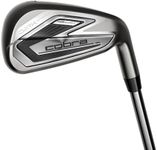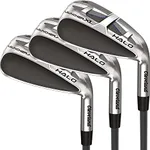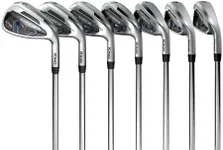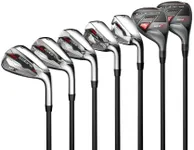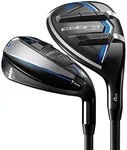Buying Guide for the Best Golf Irons
Choosing the right golf irons can make a big difference in your game, whether you’re a beginner or an experienced player. The right set of irons should match your skill level, swing style, and the kind of feel you want on the course. When shopping for golf irons, it’s important to understand the key features that affect performance, forgiveness, and playability. By learning about these specs, you’ll be able to find irons that help you hit more consistent shots and enjoy your time on the course.Clubhead DesignThe clubhead design refers to the shape and construction of the iron’s head. There are generally three types: blade, cavity back, and game improvement. Blades are thin and offer more control but are best for skilled players. Cavity backs have a hollowed-out back, making them more forgiving and suitable for most golfers. Game improvement irons are designed to help with distance and forgiveness, ideal for beginners or those who want more help with their shots. Think about your skill level and how much forgiveness you need when choosing a clubhead design.
Shaft MaterialShaft material is usually either steel or graphite. Steel shafts are heavier and provide more control and feedback, which can be good for players with faster swings. Graphite shafts are lighter and can help increase swing speed, making them a good choice for those with slower swings or who want to reduce strain on their arms. Consider your swing speed and physical comfort when deciding between steel and graphite shafts.
Shaft FlexShaft flex refers to how much the shaft bends during your swing. Common flex ratings are extra stiff, stiff, regular, senior, and ladies. Faster swing speeds usually need stiffer shafts for better control, while slower swing speeds benefit from more flexible shafts for added distance. To pick the right flex, think about how fast you swing and whether you want more control or more distance.
Set CompositionSet composition means which irons are included in the set, such as 3-iron through pitching wedge, or just 5-iron through pitching wedge. Some sets include hybrids instead of long irons for easier hitting. If you struggle with longer irons, consider a set with hybrids or fewer long irons. Choose a set composition that matches your comfort level and the types of shots you want to play.
LoftLoft is the angle of the clubface, which affects how high and far the ball goes. Lower-numbered irons have less loft and hit the ball farther but lower, while higher-numbered irons have more loft for higher, shorter shots. Understanding loft helps you choose irons that fill the distance gaps in your game. Think about the distances you need to cover and how high you want your shots to fly.
ForgivenessForgiveness refers to how well the iron performs on off-center hits. More forgiving irons help reduce the negative effects of mishits, making them ideal for beginners or those who don’t always hit the center of the clubface. Less forgiving irons offer more control but require more precision. Consider your consistency and how often you hit the sweet spot when deciding how much forgiveness you need.
Feel and FeedbackFeel and feedback describe how much information you get from the club when you hit the ball. Some irons provide a soft, responsive feel, letting you know exactly how you struck the ball, while others dampen vibrations for more comfort. If you want to improve your skills and enjoy knowing how you hit each shot, look for irons with more feedback. If you prefer comfort and less vibration, choose irons designed for a softer feel.
